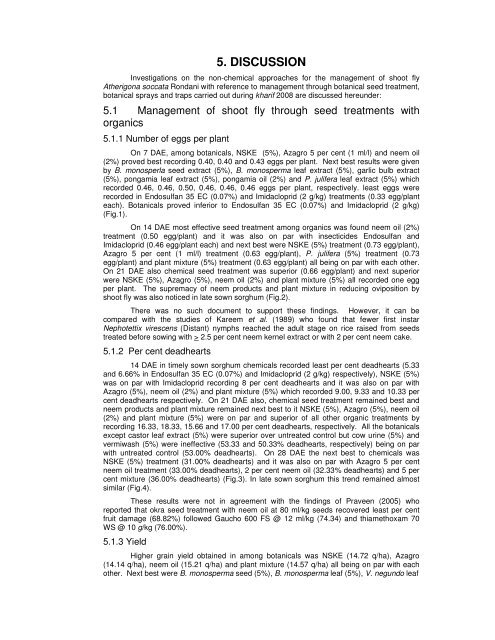NON-CHEMICAL APPROACHES FOR THE MANAGEMENT OF ...
NON-CHEMICAL APPROACHES FOR THE MANAGEMENT OF ...
NON-CHEMICAL APPROACHES FOR THE MANAGEMENT OF ...
You also want an ePaper? Increase the reach of your titles
YUMPU automatically turns print PDFs into web optimized ePapers that Google loves.
5. DISCUSSION<br />
Investigations on the non-chemical approaches for the management of shoot fly<br />
Atherigona soccata Rondani with reference to management through botanical seed treatment,<br />
botanical sprays and traps carried out during kharif 2008 are discussed hereunder:<br />
5.1 Management of shoot fly through seed treatments with<br />
organics<br />
5.1.1 Number of eggs per plant<br />
On 7 DAE, among botanicals, NSKE (5%), Azagro 5 per cent (1 ml/l) and neem oil<br />
(2%) proved best recording 0.40, 0.40 and 0.43 eggs per plant. Next best results were given<br />
by B. monosperla seed extract (5%), B. monosperma leaf extract (5%), garlic bulb extract<br />
(5%), pongamia leaf extract (5%), pongamia oil (2%) and P. julifera leaf extract (5%) which<br />
recorded 0.46, 0.46, 0.50, 0.46, 0.46, 0.46 eggs per plant, respectively. least eggs were<br />
recorded in Endosulfan 35 EC (0.07%) and Imidacloprid (2 g/kg) treatments (0.33 egg/plant<br />
each). Botanicals proved inferior to Endosulfan 35 EC (0.07%) and Imidacloprid (2 g/kg)<br />
(Fig.1).<br />
On 14 DAE most effective seed treatment among organics was found neem oil (2%)<br />
treatment (0.50 egg/plant) and it was also on par with insecticides Endosulfan and<br />
Imidacloprid (0.46 egg/plant each) and next best were NSKE (5%) treatment (0.73 egg/plant),<br />
Azagro 5 per cent (1 ml/l) treatment (0.63 egg/plant), P. julifera (5%) treatment (0.73<br />
egg/plant) and plant mixture (5%) treatment (0.63 egg/plant) all being on par with each other.<br />
On 21 DAE also chemical seed treatment was superior (0.66 egg/plant) and next superior<br />
were NSKE (5%), Azagro (5%), neem oil (2%) and plant mixture (5%) all recorded one egg<br />
per plant. The supremacy of neem products and plant mixture in reducing oviposition by<br />
shoot fly was also noticed in late sown sorghum (Fig.2).<br />
There was no such document to support these findings. However, it can be<br />
compared with the studies of Kareem et al. (1989) who found that fewer first instar<br />
Nephotettix virescens (Distant) nymphs reached the adult stage on rice raised from seeds<br />
treated before sowing with > 2.5 per cent neem kernel extract or with 2 per cent neem cake.<br />
5.1.2 Per cent deadhearts<br />
14 DAE in timely sown sorghum chemicals recorded least per cent deadhearts (5.33<br />
and 6.66% in Endosulfan 35 EC (0.07%) and Imidacloprid (2 g/kg) respectively), NSKE (5%)<br />
was on par with Imidacloprid recording 8 per cent deadhearts and it was also on par with<br />
Azagro (5%), neem oil (2%) and plant mixture (5%) which recorded 9.00, 9.33 and 10.33 per<br />
cent deadhearts respectively. On 21 DAE also, chemical seed treatment remained best and<br />
neem products and plant mixture remained next best to it NSKE (5%), Azagro (5%), neem oil<br />
(2%) and plant mixture (5%) were on par and superior of all other organic treatments by<br />
recording 16.33, 18.33, 15.66 and 17.00 per cent deadhearts, respectively. All the botanicals<br />
except castor leaf extract (5%) were superior over untreated control but cow urine (5%) and<br />
vermiwash (5%) were ineffective (53.33 and 50.33% deadhearts, respectively) being on par<br />
with untreated control (53.00% deadhearts). On 28 DAE the next best to chemicals was<br />
NSKE (5%) treatment (31.00% deadhearts) and it was also on par with Azagro 5 per cent<br />
neem oil treatment (33.00% deadhearts), 2 per cent neem oil (32.33% deadhearts) and 5 per<br />
cent mixture (36.00% deadhearts) (Fig.3). In late sown sorghum this trend remained almost<br />
similar (Fig.4).<br />
These results were not in agreement with the findings of Praveen (2005) who<br />
reported that okra seed treatment with neem oil at 80 ml/kg seeds recovered least per cent<br />
fruit damage (68.82%) followed Gaucho 600 FS @ 12 ml/kg (74.34) and thiamethoxam 70<br />
WS @ 10 g/kg (76.00%).<br />
5.1.3 Yield<br />
Higher grain yield obtained in among botanicals was NSKE (14.72 q/ha), Azagro<br />
(14.14 q/ha), neem oil (15.21 q/ha) and plant mixture (14.57 q/ha) all being on par with each<br />
other. Next best were B. monosperma seed (5%), B. monosperma leaf (5%), V. negundo leaf
















